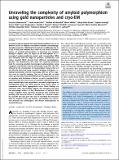| dc.contributor.author | Alexander-Katz, Alfredo | |
| dc.date.accessioned | 2020-09-10T14:10:10Z | |
| dc.date.available | 2020-09-10T14:10:10Z | |
| dc.date.issued | 2020-03 | |
| dc.identifier.issn | 0027-8424 | |
| dc.identifier.uri | https://hdl.handle.net/1721.1/127226 | |
| dc.description.abstract | Increasing evidence suggests that amyloid polymorphism gives rise to different strains of amyloids with distinct toxicities and pathology-spreading properties. Validating this hypothesis is challenging due to a lack of tools and methods that allow for the direct characterization of amyloid polymorphism in hydrated and complex biological samples. Here, we report on the development of 11-mercapto-1-undecanesulfonate-coated gold nanoparticles (NPs) that efficiently label the edges of synthetic, recombinant, and native amyloid fibrils derived from different amyloidogenic proteins. We demonstrate that these NPs represent powerful tools for assessing amyloid morphological polymorphism, using cryogenic transmission electron microscopy (cryo-EM). The NPs allowed for the visualization of morphological features that are not directly observed using standard imaging techniques, including transmission electron microscopy with use of the negative stain or cryo-EM imaging. The use of these NPs to label native paired helical filaments (PHFs) from the postmortem brain of a patient with Alzheimer's disease, as well as amyloid fibrils extracted from the heart tissue of a patient suffering from systemic amyloid light-chain amyloidosis, revealed a high degree of homogeneity across the fibrils derived from human tissue in comparison with fibrils aggregated in vitro. These findings are consistent with, and strongly support, the emerging view that the physiologic milieu is a key determinant of amyloid fibril strains. Together, these advances should not only facilitate the profiling and characterization of amyloids for structural studies by cryo-EM, but also pave the way to elucidate the structural basis of amyloid strains and toxicity, and possibly the correlation between the pathological and clinical heterogeneity of amyloid diseases. | en_US |
| dc.language.iso | en | |
| dc.publisher | Proceedings of the National Academy of Sciences | en_US |
| dc.relation.isversionof | 10.1073/pnas.1916176117 | en_US |
| dc.rights | Article is made available in accordance with the publisher's policy and may be subject to US copyright law. Please refer to the publisher's site for terms of use. | en_US |
| dc.source | PNAS | en_US |
| dc.title | Unraveling the complexity of amyloid polymorphism using gold nanoparticles and cryo-EM | en_US |
| dc.type | Article | en_US |
| dc.identifier.citation | Cendrowska, Urszula et al. “Unraveling the complexity of amyloid polymorphism using gold nanoparticles and cryo-EM.” Proceedings of the National Academy of Sciences of the United States of America, 117, 12 (March 2020): 6866–6874 © 2020 The Author(s) | en_US |
| dc.contributor.department | Massachusetts Institute of Technology. Department of Materials Science and Engineering | en_US |
| dc.relation.journal | Proceedings of the National Academy of Sciences of the United States of America | en_US |
| dc.eprint.version | Final published version | en_US |
| dc.type.uri | http://purl.org/eprint/type/JournalArticle | en_US |
| eprint.status | http://purl.org/eprint/status/PeerReviewed | en_US |
| dc.date.updated | 2020-09-02T17:00:03Z | |
| dspace.date.submission | 2020-09-02T17:00:06Z | |
| mit.journal.volume | 117 | en_US |
| mit.journal.issue | 12 | en_US |
| mit.license | PUBLISHER_POLICY | |
| mit.metadata.status | Complete | |
